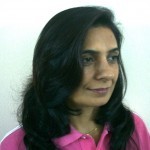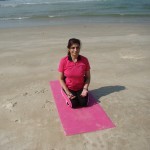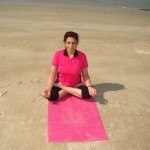 By Dr. Rita Khanna
By Dr. Rita Khanna
‘Breath is life; hence the better we breathe, the better we live.’ Of course, we all know this, but we don’t bother much about it and don’t care as often as necessary.’ The science of breath is more complicated than it appears. To breathe slowly is to prolong one’s youth and life. So say the Yogic texts caution us to breathe as if, at birth, only a fixed and immutable number of breaths had been allotted to us. If this is so, each slow breath we take preserves our precious respiratory credit balance and prolongs our existence.
Our Respiratory System
The science of breath begins with organs of respiration that consist of two lungs, one on either side of the chest, and the air passages that lead to them. The lungs are located in the upper thoracic cavity of the chest, one on each side of the median line, and are separated from the heart, the greater blood vessels, and the larger air tubes. The lungs are spongy and porous, and their tissues are very elastic, containing innumerable air sacs or alveoli. Each lung consists of an apex and a base. The base is directed towards the diaphragm, the muscular septum, and the dividing wall between the chest and the abdomen.
Air Passages
The air passage consists of the interior of the nose, pharynx or throat, larynx or voice box, trachea or windpipe, right and left bronchi, and the smaller bronchial tubes. When we breathe, we draw in the air through the nose. After it has passed through the pharynx and larynx, it passes into the trachea, thence into the right and left bronchial tubes, which in turn subdivide into innumerable smaller tubes called bronchioles, which terminate in minute subdivisions in the millions of small air sacs of the lungs. When spread out over an unbroken surface, these air sacs of the lungs would cover an area of 1,40,000 square feet.
Diaphragm
The air is drawn into the lungs by the action of the diaphragm. When it expands, the size of the chest and the lungs increases, and the outside air rushes into the vacuum thus created. The chest and lungs contract when the diaphragm relaxes and the air is expelled from the lungs.
Process of Purification
The lungs purify the blood. The blood starts its arterial journey bright red, richly laden with life-giving qualities and properties. It returns by the venous route blue, laden with the waste matter of the system. From the right side of the heart, the impure blood goes to the lungs for purification. It is distributed among the millions of tiny air cells of the lungs. A breath of air is inhaled, and the air’s oxygen comes in contact with the impure blood through the thin walls of the hair-like blood vessels of the lungs called pulmonary capillaries. The walls of the capillaries are very thin, like muslin cloth, and thus oxygen easily penetrates through the walls of these thin capillaries.
About Blood
When oxygen comes in contact with the tissues, a form of combustion takes place. The blood takes up oxygen and releases carbonic acid gas generated from the waste products and poisonous matter gathered by the blood from all parts of the system. The purified blood passes into the different arteries of the body. In a day, 35,000 pints of blood traverse the lungs’ capillaries for purification.
Control of Prana
By controlling the motion of the lungs or respiratory organs, we can control the Prana that is vibrating inside. The mind is fastened to Prana, like a bird to a string; therefore, by control of Prana, the mind can be easily controlled. Just as the bird tied to a post by a string, after flying here and there, finds its resting place on the post, this mind-bird, after running hither and thither to various sensual objects, finds its resting place during deep sleep in Prana.
Sitting Posture for Pranayama
 Sit up with your spine erect, in any Meditative pose. Close eyes. Place hands in the Mudra of your choice, ideally Chin or Jnana Mudra, with the tips of the thumb and index finger touching. Remember, the pressure on the index finger may have an opposite/varying impact.
Sit up with your spine erect, in any Meditative pose. Close eyes. Place hands in the Mudra of your choice, ideally Chin or Jnana Mudra, with the tips of the thumb and index finger touching. Remember, the pressure on the index finger may have an opposite/varying impact.
The index finger is related to the element of air or Vayu. Touching the index fingertip gently increases the air element. Pressing it down controls or decreases it.
Three Components
Pranayama has three components: the external breath, the internal breath, and the steady state between the two. When the breath is expired, it is Rechaka, the first kind of Pranayama. If the breath is drawn in, the second is termed Pooraka. Lastly, when the breath is suspended, it is the third kind, called Kumbhaka or retention of breath.
Kumbhaka increases the lifespan of an individual. It augments the inner spiritual force, vigor, and vitality. If you retain the breath for one minute, this one minute is added to your span of life. By taking the breath to the Brahmarandhra, the fontanelle at the top of the head (said to be the connecting point between the spirit and the body), and keeping it there, the Yogi can defeat the lord of death, Yama, and conquer death.
Duration
In the practice of Pranayama, Rechaka, Pooraka, and Kumbhaka are controlled and regulated by space, time, and number. The duration of the inhalation, exhalation, or retention is 1:4:2. The practices of Pranayama can be done while sitting, walking, and lying down.
Pranayama While Walking
Walk with the head up, shoulders back,, and chest expanded. Inhale slowly through both nostrils, counting Aum mentally three times, one count for each step. Then exhale slowly through both nostrils while you count six Aums (if it is possible). This completes one set. If you find it difficult to count Aum with each step, count Aum without being concerned with the steps.
If you want to do this Pranayama with retention, then after inhalation, retain the breath while you count 12 Aums (if you can), then exhale slowly through both nostrils while you count six Aums.
Kapalbhati Pranayama
This Pranayama can also be done during walking. Those who are very busy can practice during their morning and evening walks. It is like killing two birds with one stone. You will find it very pleasant to practice Pranayama while walking in an open space when a delightful gentle breeze is blowing. You will be invigorated and innervated quickly and to a considerable degree. Practice, feel, and realize this kind of Pranayama’s marked, beneficial influence. Those who walk briskly, repeating Aum mentally or verbally, practice this natural Pranayama without effort.
Pranayama While Lying Down
Those who are very weak can practice Pranayama in this pose while lying on the ground or the bed.
Posture: Lie down on your back on a blanket comfortably. Keep your hands on the ground by your sides and your legs straight. The heels should be kept together, but the toes can remain slightly apart. Relax all the muscles and the nerves.
Slowly Draw the Breath
Draw the breath slowly inside through both nostrils without making any noise. Retain the breath as long as you can do so with comfort. Then exhale slowly through both nostrils. Repeat the process 12 times in the morning and 12 times in the evening. Chant Aum mentally with each breath. If you like, you can also practice in Sukhasana, an easy, comfortable sitting posture. This gives rest not only to the body but also to the mind. It provides relief, comfort, and ease. This is very suitable for aged people.
Alternate Nostril Breathing
Sit in Padmasana or any comfortable pose. Close your eyes. Concentrate on Trikuti, the space between the two eyebrows. Close the right nostril with your right thumb. Inhale slowly through the left nostril as long as you can comfortably do it. Then exhale very, very slowly through the same nostril. Do it 12 times. This is one round.
Then inhale through the right nostril by closing the left nostril with your right ring and little fingers and exhale very slowly through the same nostril. Do it 12 times. This is one round.
Ishta Mantra
Do not make any sound during inhalation and exhalation. Mentally repeat your Ishta Mantra during practice. In the second week of practice, do two rounds; in the third week, do three rounds. Take a rest for two minutes when one round is over. Taking a few normal breaths when one round is over will give you sufficient rest, and you will be fresh for the next round. There is no Kumbhaka in this exercise. You can increase the number of rounds according to your strength and capacity.
Sukha Purvaka (easily comfortable) Pranayama
Sit in Padmasana or Siddhasana or any comfortable pose in your Meditation room  before the picture of your Ishta Devata, guiding deity. Close the right nostril with the right thumb and inhale very-very slowly through the left nostril. Then close the left nostril with your little ring fingers of the right hand. Retain the breath as long as comfortable. Then exhale very-very slowly through the nostril after releasing the thumb. Now half the process is over. Then draw air through the right nostril. Retain the air as before and exhale it very-very slowly through the left nostril.
before the picture of your Ishta Devata, guiding deity. Close the right nostril with the right thumb and inhale very-very slowly through the left nostril. Then close the left nostril with your little ring fingers of the right hand. Retain the breath as long as comfortable. Then exhale very-very slowly through the nostril after releasing the thumb. Now half the process is over. Then draw air through the right nostril. Retain the air as before and exhale it very-very slowly through the left nostril.
Mental Attitude
All these six processes constitute one Pranayama. Do 20 in the morning and 20 in the evening and gradually increase the number. Have the Bhava a mental attitude that all the divine qualities such as mercy, love, forgiveness, Shanti, joy, etc. are entering into your system along with the inhalation. As you breathe out, feel all the devilish qualities, such as lust, anger, greed, etc. being thrown out. Repeat Aum or Gayatri Mantra mentally during Pooraka, Kumbhaka, and Rechaka. This Pranayama removes all diseases, purifies the Nadis, steadies the mind in concentration, increases the digestive fire and appetite, helps to maintain Brahmacharya, and awakens the Kundalini that is sleeping at the Mooladhara Chakra.
Pranava Pranayama for Meditation
The three processes of Pranayama – expiration, inspiration, and retention – each correspond to a letter of the Sanskrit alphabet forming the Mantra Aum. Sitting in Padmasana, Meditate on the tip of the nose, visualizing the Devi as Gayatri, a girl of red complexion, surrounded by numberless rays like the image of the moon, mounted on a Swan, Hamsa, and holding a mace in her hand. She is the visible symbol of the Sanskrit letter ‘A.’ The Sanskrit letter ‘U’ has its visible symbol Savitri, a young lady of white complexion holding a disc in her hand, riding on an eagle, Garuda. The Sanskrit letter ‘M’ has its visible symbol Saraswati, an aged woman of black complexion, riding on a bull, holding a trident in her hand.
The Source
The aspirant should meditate that the single letter, the supreme light – the Pranava Aum is the origin or source of these letters and draw up the air through Ida Nadi and the left nostril on the syllable A. Then, retaining the inspired air, one should meditate on syllable U. The aspirant should then exhale, meditating on the syllable M.
Conclusion
There is no purificatory action greater than Pranayama. Just as a goldsmith removes the impurities of gold by heating it in the hot furnace, by strongly blowing the blowpipe, the Yogic aspirant also removes the impurities of the body, the senses, and the mind by blowing the lungs through the practices of Pranayama. Thus Manu says: “Let Pranayama burn up the defects.” This is just the tip of the iceberg, when referring to the science of breath.
Note: If one is not feeling comfortable with retention, one should avoid it.
Aum Shanti
If you feel inspired by this article, feel free to publish it in your Newsletter or on your Website. Our humble request is to please include the Resource as follows:
Courtesy: Dr. Rita Khanna’s Yogashaastra Studio.
A popular studio that helps you find natural solutions for complete health.
Also conducts online Yoga Courses & Naturopathy Guidance.
Mobile: + 919849772485
Ph:-91-40-65173344
Dr. Rita Khanna
Dr. Rita Khanna is a well-known name in Yoga and Naturopathy. She was initiated into this discipline over 25 years ago by the world-famous Swami Adyatmananda of Sivananda Ashram in Rishikesh (India).
Dr. Rita Khanna firmly believes that Yoga is a scientific process that helps us to lead a healthy and disease-free life. Additionally, she is also actively involved in practicing alternative medicines like Naturopathy. Over the years, she has been successfully practicing these therapies and providing succor to several chronic and terminally ill patients through Yoga, Diet, and Naturopathy. She is also imparting Yoga Teachers Training.
Dr. Rita Khanna is currently running a Yoga Studio in Secunderabad (Hyderabad, India).
Please visit the following link to see our online Yoga teacher training courses.
https://aurawellnesscenter.com/store/
Are you interested in Meditation Teacher Training?
Click here to see our online Yoga Nidra teacher training course.
Are you an experienced teacher looking for YACEP credits or continuing education?
Subscribe to Our Newsletter for Special Discounts and New Products
Related Resources
52 Essential Principles of Yoga Philosophy to Deepen your Practice
by Rina Jakubowicz
A Relaxing Way to De-stress, Re-energize, and Find Balance
by: Gail Boorstein Grossman.
YOGA: THE PATH TO HOLISTIC HEALTH
by B.K.S. Iyengar
TEACHING YOGA: Essential Foundations and Techniques
By Mark Stephens

VERY GOOD ARTICLE !
a very good yoga article and make me lots to learn thanks.
Breath is life. Yoga teaches us to take breath correctly and help to remove the impurities from the body and mind. Very much informative article, Thanks for sharing.
Pranayama removes all diseases, purifies the Nadis, steadies the mind in concentration, increases the digestive fire and appetite, helps to maintain Brahmacharya and awakens the Kundalini that is sleeping at the Mooladhara Chakra.
Thanks!